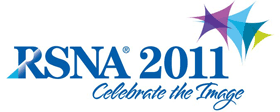
Abstract Archives of the RSNA, 2011
SSK14-08
Dose and Scoliosis Radiographic Examination: How Can a Slit-scanning System Reduce Considerably Irradiation by Managing Scatter Reduction?
Scientific Formal (Paper) Presentations
Presented on November 30, 2011
Presented as part of SSK14: Pediatrics (Radiation Dose Reduction)
Sylvain Deschênes PhD, Presenter: Nothing to Disclose
Guy Charron MSc, Abstract Co-Author: Nothing to Disclose
Josee Dubois MD, Abstract Co-Author: Nothing to Disclose
Gilles Beaudoin, Abstract Co-Author: Research grant, Siemens AG
Research grant, biospace med
To evaluate the physical performance and clinical dose benefits of a slit-scanning X-ray imaging system compared to full-field systems.
A slit-scanner (EOS Imaging, Paris, France) is compared to DR systems using Trixell flat panel detectors on the basis of Effective Detective Quantum Efficiency (DQEeff). This metric adjusts the standard DQE of the systems by discarding the scattered radiation and keeping only the part of the signal coming from primary photons. Scatter fraction is evaluated by measuring signal intensity in images of a RANDO anthropomorphic phantom (Phantom Laboratory, Salem, NY) before and after placing a lead shield where apertures (3mm diameter) are aligned with different anatomical regions. For full-field systems, the scatter fraction is assessed with and without the anti-scatter grid in place.
To correlate the DQEeff results with dose, equivalent technical parameters are estimated for scoliosis X-rays on the slit-scanner and the DR. This is done by analysing signal-to-noise ratios and contrast-to-noise ratios computed on images of a step phantom made of PMMA and Aluminum. Then, using entrance air kerma for the matching techniques, effective dose is computed by Monte Carlo simulation for each system.
For an x-ray spectrum equivalent to scoliosis examination (RQA7), DQE for DR (0.47) is more than twice as large as for slit-scanner (0.22). However, for a region along the thoracic spine, the slit-scanner has a DQEeff (0.20) three times higher than DR with anti-scatter grid (0.06). This correlates with a substantial dose reduction in scoliosis examination, effective dose being seven times lower for the slit-scanner (55 μSv) compared to DR(386 μSv).
When considering its efficacy to block scatter radiation, the slit-scanner offers higher performances than DR. This allows substantial dose reductions without compromising image quality.
The study shows that adolescent patients being x-rayed for scoliosis follow-up with slit-scanner technology can have quality radiographs while receiving considerably less radiation dose.
Deschênes, S,
Charron, G,
Dubois, J,
Beaudoin, G,
Dose and Scoliosis Radiographic Examination: How Can a Slit-scanning System Reduce Considerably Irradiation by Managing Scatter Reduction?. Radiological Society of North America 2011 Scientific Assembly and Annual Meeting, November 26 - December 2, 2011 ,Chicago IL.
http://archive.rsna.org/2011/11016386.html

